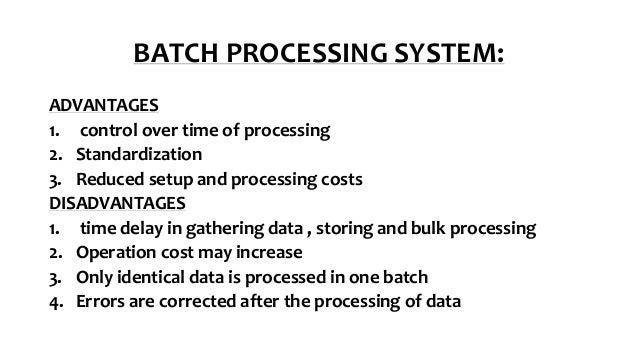
Here are some advantages of batch systems:- • Repeated jobs are done fast in batch systems without user interaction. • You don’t need special hardware and system support to input data in batch systems. • Best for large organizations but small organizations can also benefit from it. • Batch systems can work offline so it makes less stress on processor. • Processor consumes good time while processing that mean it knows which job to process next. In real time systems we don’t have expectation time of how long the job is and what is estimated time to complete it.
Feb 1, 2018 - Advantages And Disadvantages Of Serial Processing Operating System. System; Real time Operating System; Multi-processing System. In batch system, major task of operation system is to transfer Control automatically from one job to the next.Advantages:Resource Management and Allocation is very easy.Faster than serial Processing.Disadvantages:Lack of interaction between the user and the job while job is executing.
But in batch systems the processor knows how long the job is as it is queued. • Sharing of batch system for multiple users. • The idle time batch system is very less. • You can assign specific time for the batch jobs so when the computer is idle it starts processing the batch jobs i.e. At night or any free time.
• The batch systems can manage large repeated work easily.
CST-101 Block 4 Unit 1 Operting Systems CST-101 Block 4 Unit 1 Operating Systems f EVOLUTION OF OPERATING SYSTEMS An operating system may process its task serially (sequentially) or concurrently (several tasks simultaneously). It means that the resources of the computer system may be dedicated to a single program until its completion or they may be.
Eleventa punto de venta full crack software 2017. Allocated among several programs in different stages of execution. The feature of operating system to execute multiple programs in interleaved fashion or different time cycles is called as multiprogramming systems. In this section, we will try to trace the evolution of operating system. In particular, we will describe serial processing, batch processing and multiprogramming.
Serial Processing Programming in 1's and 0's (machine language) was quite common for early computer systems. Instruction and data used to be fed into the computer by means of console switches or perhaps through a hexadecimal keyboard. Programs used to be started by loading the program computer register with the address of the first instruction of a program and its result (program) used to be examined by the contents of various registers and memory locations of the machine.
Therefore, programming in this style caused a low utilisation of both users and machine. Advent of Input/Output devices, such as punched cards paper tape and language translators (Compiler/Assemblers) brought a significant step in computer system utilization. Program started being coded into programming language are first changed into object code (binary code) by translator and then automatically gets loaded into memory by a program called loader. After transferring a control to the loaded program, the execution of a program begins and its result gets displayed or printed. Once in memory, the program may be re-run with a different set of input data. The process of development and preparation of a program in such environment is slow and cumbersome due to serial processing and numerous manual processing. In a typical sequence first the editor is called to create a source code of user program written in programming language, translator is called to convert a source code into binary code and then finally loader is called to load executable program into main memory for execution.